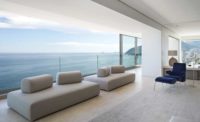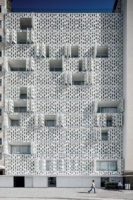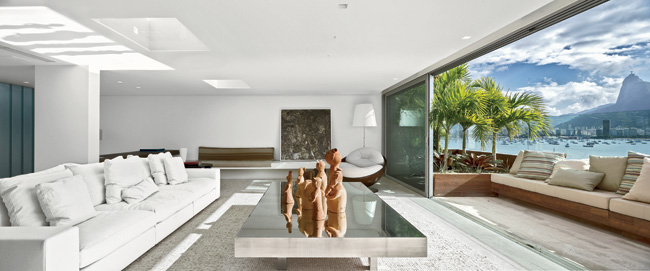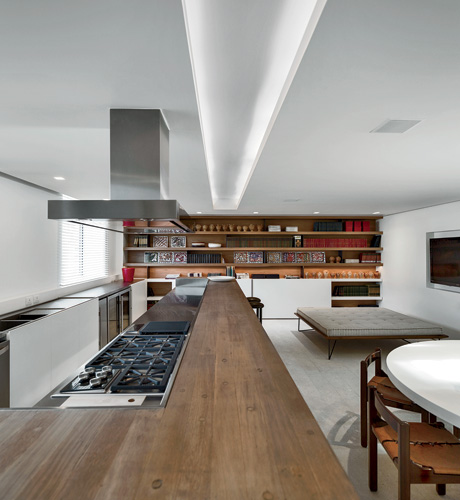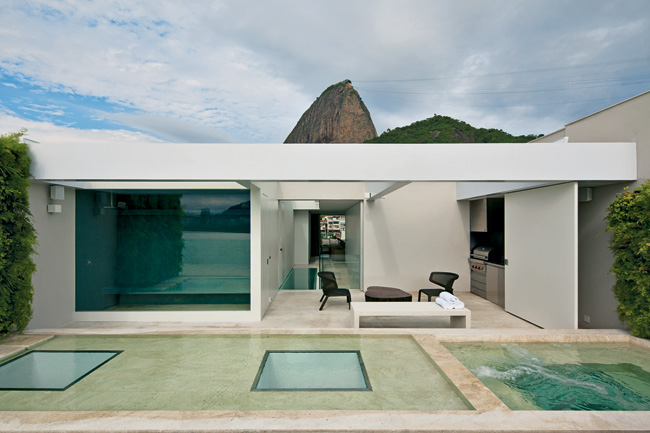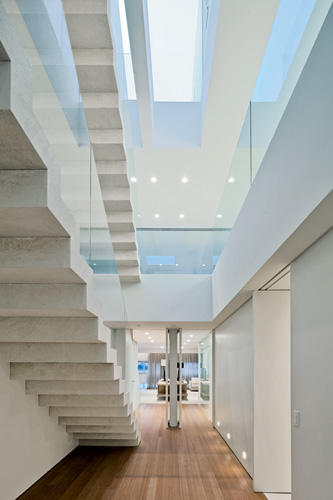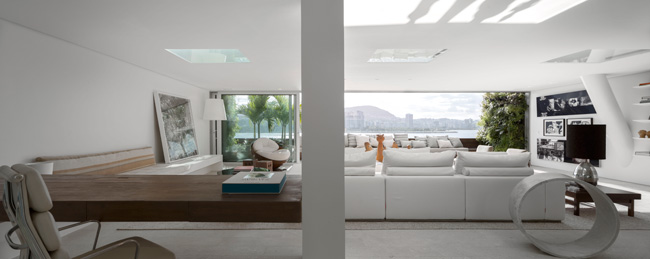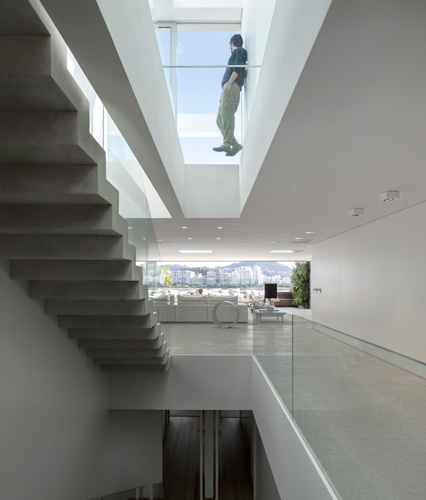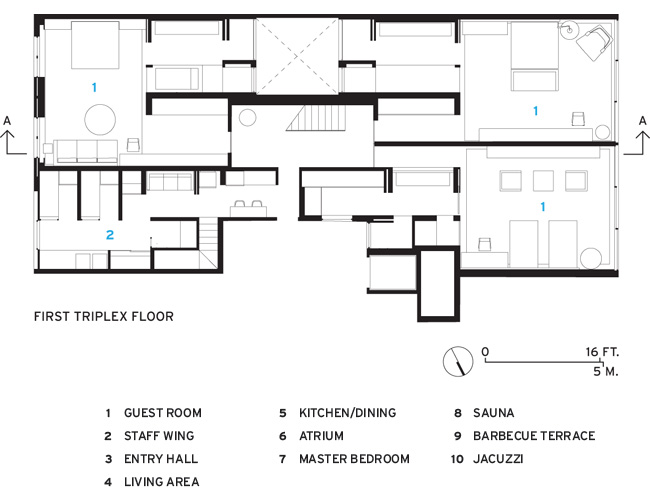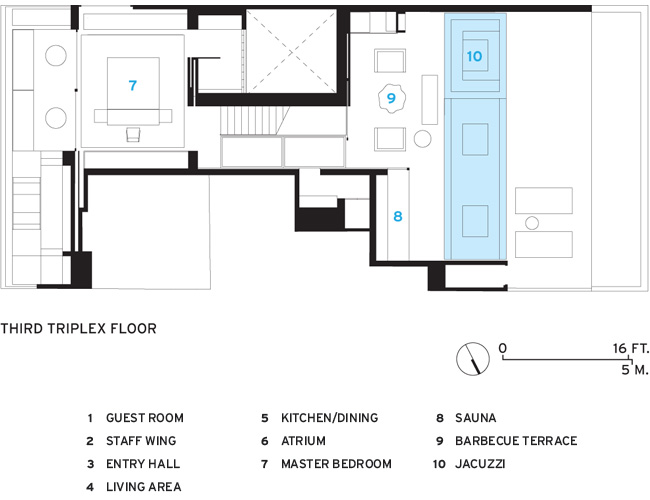Urca Penthouse
Machine for Viewing: The renovation of the top floors of a 1960s apartment building created in an airy triplex with breathtaking panoramic views of Rio de Janeiro.


































Architects & Firms
Rio de Janeiro
“In Rio, the landscape comes to you,” Brazilian architect Arthur Casas says about his commission to renovate a penthouse apartment in Rio de Janeiro's Urca neighborhood. Casas, who has an office in São Paulo, plus one in New York City, had quite a landscape to work with. The rear of the apartment looks southeast onto Sugar Loaf Mountain; the front faces west to the forested mountain ridge that culminates in the Cristo Redentor (Christ the Redeemer) statue on Corcovado Mountain; to the north, residents have long vistas across Guanabara Bay.
An avowed modernist, Casas was ideally suited to designing the spec residence, which sets off the sensuous landscape to stunning effect, for a London property investor. The architect, known for his light, planar volumes, and stringency of line, graduated from São Paulo’s Mackenzie Presbyterian University in 1983. As a product of the city’s distinct Paulista school (a term for those influenced by, among others, Pritzker prizewinner Paulo Mendes da Rocha and his concrete architecture), Casas says, “Our architecture in São Paulo is different from Rio’s, because we use a straighter line while Cariocas use more curves.” But he acknowledges that his firm, Studio Arthur Casas, owes much, as well, to the late Rio-born architectural giant Oscar Niemeyer, who died last year at 104. “Before Niemeyer, Brazilian architecture was inward-looking,” he says. “Niemeyer’s transparency of material and his feeling for the landscape was more influential than his use of the curved line.”
The five-story, poured-in-place concrete apartment building was one of several low-rise residential blocks built in the 1960s along the quiet seafront. Later, stricter building codes were instituted to protect this urban oasis of calm from the unruly high-rise development that scarred much of the city. Although the actual dwelling had been a duplex—a fourth-floor apartment integrated with the penthouse above—Casas wanted to create a triplex. Since the building’s height could not be altered, the architect worked with the space around the roof’s water tanks and the elevator housing to create a bird's nest of a master bedroom. It is invisible from the street because of wood sun decks located at the perimeter.
Since the building is flanked by similar structures, a major challenge was to bring more light into the apartment’s interior. Casas organized the three levels around a central-stair hall topped by a generous skylight. He placed the main entrance, along with the living and dining areas, on the middle level, sandwiched between the lower level—for three guest rooms and staff quarters—and the upper, rooftop, master-bedroom suite. The natural illumination filtering down through the three floors is enhanced by a glass floor in the top level of the hall and glass balustrades edging the staircase. Several more skylights in the living room allow light to pour in from the sun deck above and permeate the far reaches of the interior.
Invariably, the visitor’s gaze is drawn to the views of the sky, water, and iconic mountains that pervade the rooms of this 7,180-square-foot apartment, where the sun’s tropical intensity is cooled by white walls and limestone floors. Even the bathrooms have glass partitions dividing them from the bedrooms to allow the residents to enjoy the scenery as they soak in the tub.
The previous dwelling, unoccupied for some time, was in poor condition. Since the original plans were unavailable, Casas’s team gutted the unit, save for its concrete structure. This led to some discoveries, such as the presence of tubular V-shaped columns on the middle floor, which Casas decided to expose, since they are closely associated with Brazilian architecture of the 1950s and ’60s. For the renovation’s new structural requirements, Casas switched from concrete to steel, now more common here.
The result is a triumphant integration of space, light, and rectilinear structure, all devoted to capturing the astonishing views. With this expansive apartment, Casas has composed a modernist sonata to one of the world’s most spectacular cities.
Irish Times,
Size: 7,180 square feet
Cost: $1.8 million
Completion Date: March 2011
PeopleOwner: Rumi Verjee
Architect:
NY
São Paulo
Personnel in architect's firm who should receive special credit:
Engineer(s):
Consultant(s): Lighting: Franco e Fortes Acoustical: High Control (Sound and Automation) - http://www.lcorsini.com.br/ Other: Ornare (Kitchen)
General contractor:
Renderer:
CAD system, project management, or other software used: |
Products
Kitchen: Island Counter: Ecco Moveis (wood counter/shelf section) Plumbing fittings: Deca
Bathrooms/Spas: Plumbing fittings: Deca, Ducha, Hansgrohe
Interior Surfacing: Solid surfacing: Silestone Floor and wall tile (cite where used): Bisazza (third floor spa floor & walls) Resilient flooring: Neo Bamboo |

